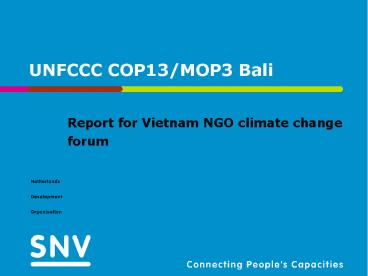UNFCCC COP13/MOP3 Bali - PowerPoint PPT Presentation
1 / 16
Title: UNFCCC COP13/MOP3 Bali
1
UNFCCC COP13/MOP3 Bali
- Report for Vietnam NGO climate change forum
2
What is COP/MOP
- United Nations Framework Convention on Climate
Change (UNFCCC) holds annual Conference of
Parties (COP) - includes all UN member states
- encourages members to combat climate change
- Kyoto Protocol signatories hold annual meetings
(MOP) alongside COPs - obliges members to combat climate change
- Bali 2007 was 13th COP and 3rd MOP
3
Key points of the Kyoto Protocol
- Only annex 1 (developed) parties have
commitments to reduce GHG emissions - Commitment period from 2008-12
- Non-annex 1 countries participate through the
CDM - Certified Emission Reductions (CERs) produced by
CDM projects can be sold and exchanged - Additionality - would the project have been
implemented without CDM?
4
Bali conference in context4th IPCC report
- IPCC produces 5-yearly reports on the state of
the global climate and anthropogenic influence - 2007 report most unequivocal yet - global GHG
emissions must be reduced 25-40 below 1990
levels before 2020. - Atmospheric GHG concentrations must be stablised
at 450-550 ppm - This will not be sufficient to avoid indundation
of small island states and low lying cities (HCMC)
5
Bali conference in contextUNFCCC agenda
- A post-2012 successor to the Kyoto Protocol
which - Includes all parties to UNFCCC
- Includes firm targets based on findings of IPCC4
- Consists of four elements mitigation,
adaptation, technology transfer, financing - Bali to reach unanimous agreement on a
negotiation framework and timetable (roadmap) - Sign post-2012 agreement in 2009 (Copenhagen)
6
Bali conference in contextPolitical environment
- G8 meeting - US admission of human-induced
climate change - Launches top emitters club
- Gives WB remit to devise FCPF
- Australian election - climate change a key issue
- Nobel Peace prize (award ceremony during Bali
conference)
7
Key players
- USA
- Blocking agreement - insisted on commitments for
developing nations and no specific targets - Technology transfer entails risk for domestic
industry - John Kerry led parallel delegation
- Al Gore advised leaving USA out of agreement,
with an opt-in for new administration
8
Key players
- Canada, Japan and Australia - key US allies
- EU
- Insisted on inclusion of IPCC targets - roadmap
must have a destination - More robust CDM mechanism
- China
- Unofficial rep of non-annex 1 parties
- Highlighted contrast with US position
- Favours looser regulation of CDM
- Brazil - REDD mechanism to be deforestation only
9
Key DecisionsBali Roadmap
- Unanimous agreement after an extra day
- IPCC targets reduced to a footnote but roadmap
recognises that deep cuts will be required - G77 pressure forced USA into a humiliating last
minute u-turn but they still managed to remove
all meaningful content - However, nothing is ruled out and there is every
chance that Copenhagen 2009 will include
commitments from all major emitters
10
Key decisionsREDD
- Reduced Emissions from Deforestation and Forest
Degradation (REDD) - the major success story of
the conference - Brazil dropped objections
- Unexpectedly broad parameters - may include
payments for conservation and restoration as well
as reduced degradation - Previous objections to forestry mechanism (poor
scientific basis and difficulty of monitoring)
expected to be overcome by 2012
11
Key decisionsREDD
- CERs will be long-term (unlike ARCDM)
- Outstanding concerns (highlighted on Forestry
day) - National accounting, not project-based - how to
distribute benefits? - Local/indigenous use rights - not adequately
addressed in the decision - Baselines - simple for avoided deforestation,
complex for other scenarios
12
Key decisionsREDD
- The next two years of negotiations will address
these concerns - Non-annex 1 Countries with an interest in REDD
have until 2013 to prepare - COP13 encouraged annex 1 parties to contribute to
REDD preparedness - WBs Forest Carbon Partnership Facility (FCPF)
was created to channel such contributions in two
stages Readiness mechanism and Carbon Finance
mechanism
13
Key decisionsNew CDM guidelines - Biogas
- MOP3 reinstated the mechanism that enables biogas
projects to generate CERs under CDM - The mechanism was previously abolished because it
was considered a proxy avoided deforestation
measure - substituting firewood - Reinstated mechanism assumes biogas plants
substitute for kerosene - Generates less CERs per plant than previous
mechanism - REDD may allow revival of original mechanism
14
Key decisionsNew CDM guidance - Energy
efficiency
- Allows for projects which result in improvements
in energy efficiency of existing technologies -
such as wood-fired stoves - Biogas and energy efficiency projects were
lobbied for by G77 nations (especially Nepal),
with the support of EU. Brazil dropped their
initial opposition
15
Key decisionsNew CDM guidance - ARCDM
- Limit on small-scale ARCDM projects doubled to
16,000 tCO2. This was pushed by African
countries - But still many obstacles to ARCDM projects
- High risk for buyers
- Temporary CERs - low value
- Outlawed by EU Emission Trading System
- Stringent monitoring requirements
- High technical capacity required
16
Key decisionsAdaptation Fund
- Adaptation fund created from 2 levy on sale of
CERs from all CDM projects - made operational at
Bali conference - 36 million currently amassed - future revenues
will be gt 100 million annually - This is not sufficient to meet non annex 1
countries demands for adaptation projects - Additional funds available from Global
Environment Facility (GEF), World Bank (eg FCPF)
and regional bodies e.g. ADB































